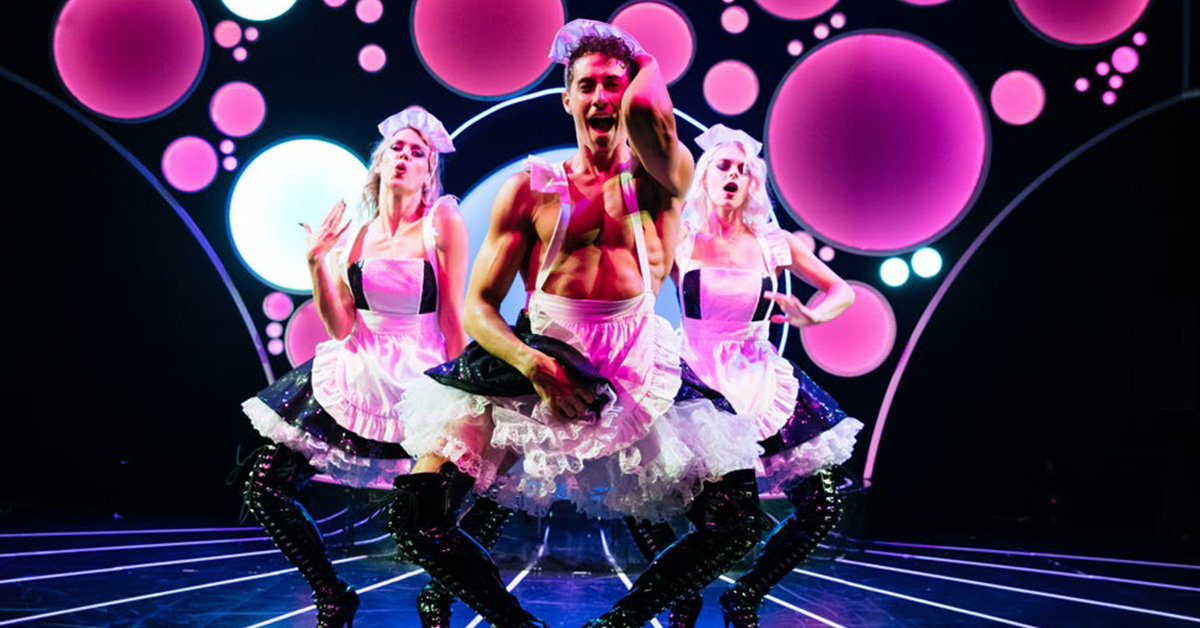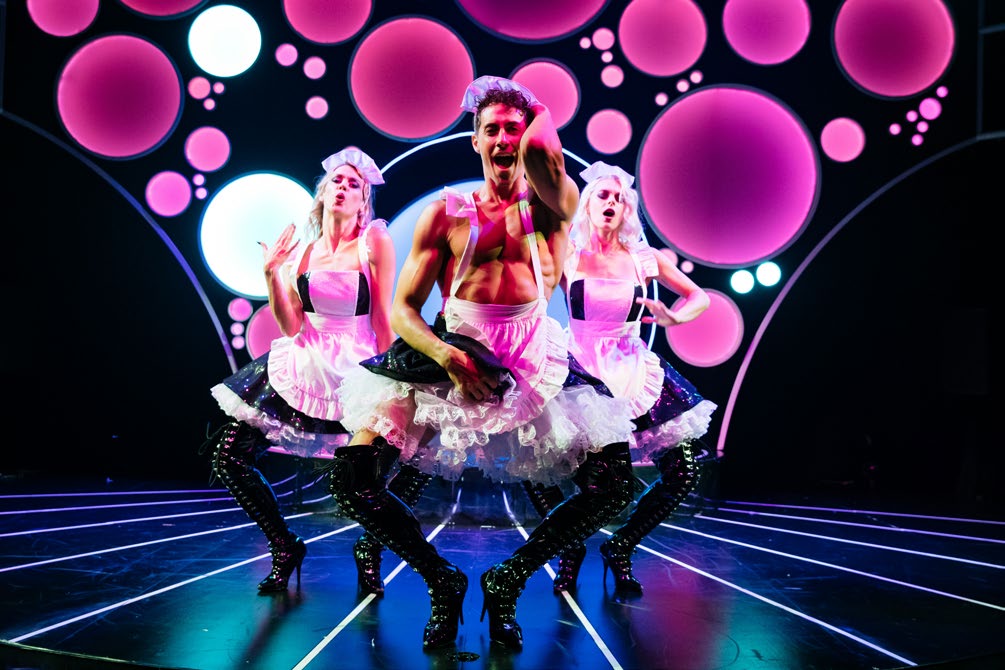
Four Corners
AUCKLAND ARTS FESTIVAL
Mirrors, Mirrors on the Walls
A visitor from Belgium arrives at Auckland’s Aotea Square this month, inviting you to an evening of Champagne bubbles, beads of sweat and glittery hot pants.
Imagine being in a small town of Belgium’s Flanders region at the turn of last century. Though you’re a worker of the land, growing sugar beets and potatoes, from time to time a delight of the quickly developing world beyond the fields reaches you. The industrial revolution is in full swing, and Belgium’s manufacturing, textile, iron, and coal industries are booming.
Just days ago, horse-drawn carriages pulled into town with a collection of performers and large wooden boxes, tens of metres long. The boxes contained thousands of wooden beams, planks, carved panels, mirrors, stained glass, heavy velvet, brocade and rope. With surprising speed, a spiegeltent, Dutch for mirror tent, was assembled.
The spiegeltent is a thing of beauty, painstakingly crafted. Used as a portable entertainment salon, dance hall and bar, it comes to life as the sun sets. Inside, the light is dim and warm. The circular shape creates a sense of intimacy, the perfect setting for wild fin-de-siecle nightlife. Harvesting vegetables is forgotten for the night, best frocks worn for waltzing, the air warms with breath. Eyes are discreetly caught in the mirrors lining the walls, and then there’s the booths. The structure, rather than being a mere sum of parts, seems to contain another world.
This month, on the red paving stones of Aotea Square, a similar portal will open. The Magic Mirrors Spiegeltent will adorn the square, triangulated between Event Cinemas, the Waharoa gateway and the Auckland Town Hall. It’s hard to imagine a more unlikely collection of architecture: Waharoa’s mythological symbols created by Selwyn Muru, the cinema covered in blue tiles with its walls angled as was all the rage in 1999, the neo-baroque clock tower of the Town Hall, and the old-world tent. But it’s not a new sight exactly. A spiegeltent has graced Auckland annually for about 20 years, as part of what is now the Te Ahurei Toi o Tāmaki Auckland Arts Festival.
“The performers are in the audience — sometimes they’re sitting on your lap.”
A few original spiegeltents, around a century old, still travel, still retain their glamour. But this one isn’t one of those. Although it’s come all the way from Belgium, the Magic Mirrors Spiegeltent is a replica. Still, “The atmosphere is very magical in there,” says Scott Maidment, the man responsible for bringing it here.
Maidment is a performer-turned-producer. He’s involved in projects close and far: the Bread & Circus World Buskers Festival (Christchurch), The Garden of Unearthly Delights (Adelaide), and travelling shows like The Purple Rabbit. He learned how to ride the unicycle, juggle, walk on stilts, and “all that sort of stuff” many years ago when he was in high school.
He was pulled away from the circus early in his career by Shakespeare, performing in a travelling troupe for many years. By 2000, he was back in cabaret shows, and for the first time performed in a spiegeltent at the Edinburgh Festival Fringe. Until then, he’d performed solely in theatres or circus tents. The atmosphere of the spiegeltent was a bit of a revelation. Maidment was enamoured with the close proximity of the performers and audience. “The show happens in, above, and around the audience. It’s not like when you go to the theatre that it happens at one end, in the proscenium arch. The performers are in the audience – sometimes they’re sitting on your lap.” It was an immediacy he hadn’t found elsewhere. Since then, he’s performed in spiegeltents in more than 18 different countries.
This time, you won’t find Maidment in anyone’s lap. He’s behind the scenes, directing the circus cabaret Blanc de Blanc Encore which for two hours each night from 9 to 26 March will grace the spiegeltent. The popularity of spiegeltents peaked in Europe in the 1920s and 30s, alongside the rise of cabaret. Like the custom-made frilled, jewelled and pleated costumes, it’s a symbol of an era. But the venue is not just a fitting setting for the performance, rather “It’s as much as part of the show as the performers,” says Maidment.
Having been, many times, among the crew who construct the tents, Maidment knows each nook and cranny, the load-bearing beams and the billowed folds of fabric. Each spiegeltent has more than 3000 parts, but not a single screw or nail. “You don’t need nuts and bolts, don’t need screws or nails or hammers. It’s just like a Meccano set, or Lego, it kind of clicks together.” He now uses this knowledge in planning shows. “I’m making shows specifically for the tent. I know how they’re put together, and how I can use them in different ways.”
Blanc de Blanc Encore is a homage to a certain sparkling drink. It’s a name used for Champagne made entirely of white grapes, usually of the chardonnay, pinot blanc or arbane varieties. Maidment loved the onomatopoeic sound of Blanc de Blanc, the way the words felt in his mouth, a little like the drink they describe. He likens the progression of the show to having a glass (or perhaps a few) of Champagne.

Pouring Champagne from on high is all part of the act for Blanc de Blanc Encore aerialist Caitlin Marion.
“At the beginning of the night, when you pop the bottle, it starts out smooth and sophisticated, and then by the end of the night, it’s a big crazy party, and everybody’s dancing on the tables.” Eight bottles of Champagne are popped during the show, some it poured directly into audience members’ mouths by an acrobat hanging upside down from a bent pole. She wears just a sparkling teddy, backless with a ruched, cheeky bottom.
Acrobat Mirko Köckenburger enters the stage, wearing a tailed tuxedo with a white shirt and bow tie. An assistant holds a tray of Champagne flutes Köckenburger proceeds to stack into ever-growing towers, testing their strength with his body weight. As they prove themselves, his acrobatic tricks intensify and items of clothing are discarded, until all that’s left is glittering hot pants, and a taut body upside down, balancing on one arm.
The cast comes from all corners: Los Angeles, Montreal, Minnesota, Toulouse (Köckenburger is from Berlin). They’re constantly on the road, “like a kind of travelling circus”, says Maidment, who hails from Adelaide, but can rarely be found there. He thinks their lives aren’t all that different from the performers in the original spiegeltents all those years ago, living a nomadic, nocturnal life, dedicated to their craft. “It’s not like they go home at night, they’re always on tour somewhere. It’s really a lifetime commitment.”
Many also perform in larger circuses like Cirque du Soleil, but you won’t see the same acts anywhere else. All are bespoke to this production. Nor would the experience be comparable in circus tents, where performers are far from the audience. “In the spiegeltent, it’s really up close and personal. You can see the bead of sweat on the brow of the performer. That kind of immediacy is great,” says Maidment. “Audiences love it.” And so too do performers, who soak up the energy in the room, and reflect it back again.
We can see beads of sweat in high definition trickling down a forehead anytime we want, but it’s hardly entertainment. There’s no magic on our palm-sized screens. No eyes to catch in the mirror. No energy in the room. Despite their magic, mirrors and energy, spiegeltents were replaced by the rising popularity of cinema and television in the 1950s. Entertainment could be beamed into small towns using exciting new technology, so people were less inclined to haul it around by horse and carriage.
A resurgence in the particular appeal of the spiegeltent was sparked in 1996 when Australian jazz pianist David Bates took The Famous Spiegeltent to the Edinburgh Festival Fringe. Possibly the most lavishly decorated of all, it was built in 1920 by master craftsmen in Belgium. Its presence at the festival was so successful it has returned every year. Now spiegeltents are shipped across the world to cities which have plenty of other venue options. Just as they always have, the circular spaces draw people together, into an intimate and communal experience.
Maidment hopes that visiting the spiegeltent can be an escape from everyday life. Much like forgetting the fields of sweet beets and potatoes, the audience can, for the evening, leave behind the woes of contemporary life and step into an atmosphere of yesteryear’s glamorous hedonism. Let the show begin!
For more information about Blanc de Blanc Encore performances, see aaf.co.nz

Director Scott Maidment looks for unapologetic performers with a twinkle in their eye.
Gabi Lardies is the junior writer for North & South, a role funded by NZ On Air’s Public Interest Journalism Fund.

This story appeared in the March 2023 issue of North & South.

